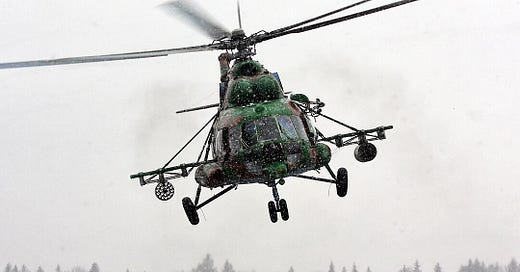Maybe A Rocket, Not A Drone, Blew Up That Russian Helicopter Near Donetsk
A key source changed his story
Maybe a Ukrainian drone didn’t shoot down a Russian helicopter for the first time.
On July 31, a Russian national guard Mil Mi-8 transport helicopter reportedly carrying 20 crew and passengers crashed shortly after takeoff near Donetsk in Russian-occupied eastern Ukraine, potentially five to 10 miles from the front line.
Russian sources, including Russian helicopter pilot and blogger Aleksey Voyevoda, initially claimed a Ukrainian drone targeted the Mi-8.
Later the same day, Voyevoda retracted his assertion—and claimed a Ukrainian rocket, fired by a High-Mobility Artillery Rocket System, destroyed the Mi-8.
“It is reported that the Mi-8 was involved in evacuating wounded soldiers, a fact later confirmed by obituaries,” the pro-Ukraine Conflict Intelligence Team reported. “The number of casualties from this strike remains unclear.”
It’s difficult to confirm what really happened. If a drone was responsible for the shoot-down, it was an important first. As long ago as September, Ukrainian operators first tried ramming their first-person-view drones into Russian helicopters mid-flight.
It’s a difficult task. A helicopter can fly faster than 150 miles per hour, thousands of feet in the air—too fast and too high for an FPV drone to get a clean shot. So it made sense that, per Voyevoda’s initial claim, a drone may have hit the helicopter while it was taking off.
While, in other words, it was low and slow.
If Voyevoda’s later claim is accurate and an M30/31 rocket from a HIMARS launcher struck the Mi-8, the Ukrainians’ accomplishment is much less impressive. Helicopters are extremely vulnerable to rockets while on or near the ground.
On or just before March 13, a Russian drone spotted a trio of Ukrainian Mi-8s or Mil Mi-17s rearming in a field in Novopavlivka, outside the ruins of Avdiivka in eastern Ukraine.
An Iskander rocket streaked in, destroying two of the helicopters and killing at least two aviators. Two months later on or just before May 11, it happened again—and in roughly the same area: near Pavlohrad, 40 miles west of Novopavlivka.
A pair of Ukrainian Mil Mi-24 attack helicopters and an accompanying Mi-17 were flying daytime missions when they landed at a forward arming and refueling point. An Iskander struck, destroying all three helicopters.
Read more:
Russia May Have Blown Up Ukraine's Yak-52 Drone-Killer
It’s possible a Russian attack on Monday damaged or destroyed that Yakovlev Yak-52 training plane…






